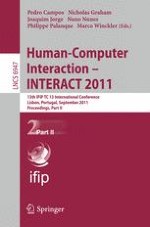2011 | Buch
Human-Computer Interaction – INTERACT 2011
13th IFIP TC 13 International Conference, Lisbon, Portugal, September 5-9, 2011, Proceedings, Part II
herausgegeben von: Pedro Campos, Nicholas Graham, Joaquim Jorge, Nuno Nunes, Philippe Palanque, Marco Winckler
Verlag: Springer Berlin Heidelberg
Buchreihe : Lecture Notes in Computer Science
